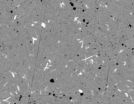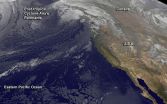IU researchers: Blood test may help to diagnose pancreatic cancer
2014-10-28
(Press-News.org) INDIANAPOLIS -- Indiana University cancer researchers have found that a simple blood test might help diagnose pancreatic cancer, one of the most deadly forms of the disease.
In research published today in the American Journal of Gastroenterology, Murray Korc, M.D., the Myles Brand Professor of Cancer Research at the Indiana University School of Medicine and a researcher at the Indiana University Melvin and Bren Simon Cancer Center, and colleagues found that several microRNAs – small RNA molecules -- circulate at high levels in the blood of pancreatic cancer patients.
"This is a new finding that extends previous knowledge in this field," Dr. Korc said. "The key new feature here is that there is a panel of microRNAs that can be measured accurately in the plasma component of blood to determine if a patient has pancreatic cancer."
Specifically, the IU research team found that an increased expression of miRNA-10b, -155, and -106b in plasma appears highly accurate in diagnosing pancreatic ductal adenocarcinoma. Pancreatic ductal adenocarcinoma is by far the most common type of pancreatic malignancy.
Dr. Korc and colleagues made the discovery by examining plasma, bile, pancreatic juice or a combination, which had been collected from 215 patients either immediately before or during an endoscopy.
Dr. Korc pointed out that additional studies are needed to confirm that a blood test could be an effective method of diagnosing pancreatic cancer.
"It may be possible to use a blood test to screen individuals who are at high risk for developing pancreatic cancer," Dr. Korc said. "We are planning to conduct such studies. It will be important to identify additional markers and to assess how useful a panel of such markers would be for the early diagnosis of this cancer. Based on our findings, this test could also be useful to differentiate between pancreatic cancer and chronic pancreatitis."
Such a marker would be an advance against metastatic pancreatic cancer because current treatments typically extend a person's life for only six to 16 weeks. Pancreatic cancer is difficult to detect and diagnose because there are no noticeable signs or symptoms in the early stages and because the pancreas is hidden behind other organs such as the stomach, small intestine, liver, gallbladder, spleen and bile ducts.
Only 6 percent of people with the disease survive more than five years after diagnosis. According to the National Cancer Institute, there will be an estimated 46,420 new cases of pancreatic cancer and 39,590 deaths from the disease in 2014.
INFORMATION:
This research was funded, in part, by NIH grants R37-CA-075059 and 5K23DK095148.
Contributing to the study were IU School of Medicine researchers Gregory A. Cote, M.D., M.S.; A. Jesse Gore, Ph.D.; Samantha D. McElyea, M.S.; Laura E. Heathers, B.A.; Huiping Xu, Ph.D.; and Stuart Sherman, M.D.
Dr. Korc was named the inaugural Myles Brand Professor of Cancer Research in October 2011. The professorship was created to help physicians and scientists at the IU Simon Cancer Center to continue investigating devastating malignancies, such as pancreatic cancer, which claimed the life of Brand, the 16th president of Indiana University. Brand served as IU's president from 1994 to 2002.
He is also director of the Center for Pancreatic Cancer Research. The center brings together nearly 50 basic scientists and clinicians who work to improve outcomes for pancreatic cancer patients.
Dr. Korc's focus is on aberrant growth-factor signaling in pancreatic cancer and genetic mouse models of pancreatic cancer, with the goal of designing novel therapeutic strategies. He has published more than 280 peer-reviewed manuscripts, and he is internationally recognized for his seminal contributions to the understanding of the role of the epidermal growth factor receptor and transforming growth factor-beta in pancreatic cancer, work for which he earned a National Institutes of Health MERIT Award. The highly-selective MERIT Awards are presented to researchers who demonstrate superior competence and outstanding productivity in research endeavors. END
ELSE PRESS RELEASES FROM THIS DATE:
2014-10-28
For magnetic fusion energy to fuel future power plants, scientists must find ways to control the interactions that take place between the volatile edge of the plasma and the walls that surround it in fusion facilities. Such interactions can profoundly affect conditions at the superhot core of the plasma in ways that include kicking up impurities that cool down the core and halt fusion reactions.
Researchers have improved plasma performance by applying lithium coatings to the walls of fusion facilities. But a complete understanding of the mechanism behind this improvement ...
2014-10-28
Each second, the sun hurls millions of tons of hot, charged plasma gas into space. This
volatile "solar wind" buffets the magnetosphere, the magnetic field that surrounds the Earth, and can whip up geomagnetic storms that disrupt cell phone service, damage satellites and blackout power grids. Precise predictions of such outbursts could prompt measures to cope with them, just as forecasts here on Earth warn of approaching hurricanes and thunderstorms.
Researchers throughout the United States are using laboratory experiments to uncover important physics behind this space ...
2014-10-28
Philadelphia, PA, October 28, 2014 – Canadian health organizations are calling upon governments to take a leadership role in creating healthy food environments. They say that implementing strategies that facilitate access to affordable healthy foods and beverages in places where Canadians work, live, and play could play a key role in preventing diet-related disease and health risk such as obesity and hypertension, and ultimately improve cardiovascular health, This call for action is published in the Canadian Journal of Cardiology.
In 2010, unhealthy eating was identified ...
2014-10-28
WASHINGTON, D.C., October 28, 2014 – Some of mankind's earliest and most mysterious artistic achievements—including prehistoric cave paintings, canyon petroglyphs and megalithic structures such as Stonehenge—may have been inspired by the behaviors of sound waves being misinterpreted as "supernatural."
During the 168th Meeting of the Acoustical Society of America (ASA), to be held October 27-31, 2014 at the Indianapolis Marriott Downtown Hotel, Steven J. Waller, of Rock Art Acoustics, will describe several ways virtual sound images and absorbers can ...
2014-10-28
WASHINGTON, D.C., October 28, 2014 – If you've ever gone for a spin in a luxury car and felt your back being warmed or cooled by a seat-based climate control system, then you've likely experienced the benefits of a class of materials called thermoelectrics. Thermoelectric materials convert heat into electricity, and vice versa, and they have many advantages over more traditional heating and cooling systems.
Recently, researchers have observed that the performance of some thermoelectric materials can be improved by combining different solid phases -- more than one ...
2014-10-28
Experiments on the DIII-D tokamak that General Atomics operates for the U.S. Department of Energy (DOE) have demonstrated the ability of lithium injections to transiently double the temperature and pressure at the edge of the plasma and delay the onset of instabilities and other transients. Researchers conducted the experiments using a lithium- injection device developed at the DOE's Princeton Plasma Physics Laboratory (PPPL).
Lithium can play an important role in controlling the edge region and hence the evolution of the entire plasma. For example, researchers have ...
2014-10-28
NASA's Terra satellite passed over Tropical Storm Hanna on Oct. 27 when it made landfall near the northern Nicaragua and southern Honduras border.
On Oct. 27 at 16:00 UTC (12 p.m. EDT) the MODIS instrument aboard NASA's Terra satellite captured a visible image of Tropical Storm Hanna straddling the border between Honduras and Nicaragua. The image, created by NASA's MODIS Rapid Response Team at NASA's Goddard Space Flight Center in Greenbelt, Maryland, showed strong thunderstorms on both sides of the border, bringing heavy rainfall to those area.
At 10 a.m. EDT on Oct. ...
2014-10-28
Scientists from North America, Europe and China have published a paper in the Proceedings of the National Academy of Sciences that reveals important details about key transitions in the evolution of plant life on our planet.
From strange and exotic algae, mosses, ferns, trees and flowers growing deep in steamy rainforests to the grains and vegetables we eat and the ornamental plants adorning our homes, all plant life on Earth shares over a billion years of history.
"Our study generated DNA sequences from a vast number of distantly related plants, and we developed new ...
2014-10-28
NOAA's GOES-West satellite captured an image of post-tropical cyclone Ana's remnant clouds raining on British Columbia, Canada today, Oct. 28. Wind warnings along some coastal sections of British Columbia continued today as the storm moved through the region.
NOAA's GOES-West satellite gathered infrared data on Ana's remnant clouds and that data was made into an image by NASA/NOAA's GOES Project at NASA's Goddard Space Flight Center in Greenbelt, Maryland. In the image the remnant clouds resemble a frontal system.
Environment Canada's Meteorological Service continued ...
2014-10-28
Asthma, which inflames and narrows the airways, has become more common in recent years. While there is no known cure, asthma can be managed with medication and by avoiding allergens and other triggers. A new study by a Tel Aviv University researcher points to a convenient, free way to manage acute asthmatic episodes — catching some rays outside.
According to a paper recently published in the journal Allergy, measuring and, if need be, boosting Vitamin D levels could help manage asthma attacks. The research, conducted by Dr. Ronit Confino-Cohen of TAU's Sackler Faculty ...
LAST 30 PRESS RELEASES:
[Press-News.org] IU researchers: Blood test may help to diagnose pancreatic cancer






